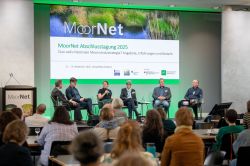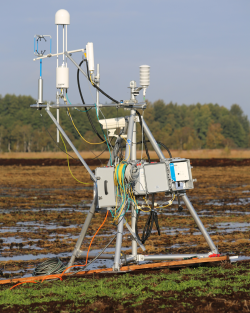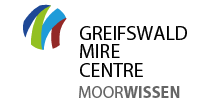News
2025
Our post-COP30 peatland series
by Berit Krondorf (comments: 0)
What about outcomes and perspectives?
28/11/2025 In our short post-COP30 peatland series we’ve asked FranziskaTanneberger for commenting with experiences from the ground as a member of the German delegation in Belém.
High on the agenda: the “Peatland Breakthrough” at the 17th November – a global call to action by a strong peatland partnership, including Greifswald Mire Centre. Why it wasn’t the breakthrough itself yet, but rather a pre-launch publishing the Science-based Framework for Global Peatland Targets & Guiding Principles, Franziska explains in this video: COP30 Series – Part 6: #Peatland Breakthrough – not yet, but... .
Nevertheless, the side event was a considerable success: Germany joined Peru and Uganda in being a Champion Country for the Peatland Breakthrough, which is a collaborative effort to accelerate and mobilize action to conserve, rewet and restore, and enable the sustainable, wise use of the world’s peatlands.
Also, Franziska Tanneberger stresses that science-based targets for peatlands Included of the official Outcome Report of the Global Climate Action Agenda at COP 30 | UNFCCC of COP30 is an encouraging outcome. Find peatland content there on p. 18 and hear more about it in this video: COP30 Series - Part 4: COP 30 Outcome
There is peatland perspective for the upcoming COPs: the next global climate summit (UNCCC) will take place in Antalya/Turkey – under Australian leadership. Of course, the country doesn’t sport as much peatlands as Brazil – the tropical country with the largest area of peatlands – but there is a lot of activity on these ecosystems especially in neighbouring Caucasian countries. And also the next meeting of the Convention on Combatting Desertification (UNCCD) in Ulan Bataar/Mongolia is likely to have a focus on peatlands. More details in:COP30 Series - Part 5: #COP30 Preview next COP
More details about peatland events on COP30 with involvement of Greifswald Mire Centre in this media information of Greifswald University.
MoorNet conclusion
by Berit Krondorf (comments: 0)
with useful outcomes

18/11/2025 Since 2022, MoorNet has been providing technical support as a research and development project for the implementation of the National Peatland Protection Strategy (Nationale Moorschutzstrategie) and networking amongst peatland protection stakeholders in Germany. With useful outcomes that are still publicly available:
The MoorNet project database provides information on projects, funding and institutions. New projects can be registered there using this form.
The MoorNet mailing list sends latest news on peatlands, and those interested can still register online.
The MoorNet final conference in mid-November 2025 demonstrated the wealth of expertise, commitment and experience within the German peatland conservation community. Over three days, more than 150 participants from administration, practice and science shared knowledge, exchanged experiences, discussed problems and debated solutions. An excursion to a rewetting project in Brandenburg completed the programme. Presentations and selected contributions from the conference will soon be published as videos at the MOORNet-Website – for anyone who would like to delve deeper into the content or review it.
Peatland at COP30
by Berit Krondorf (comments: 0)
We push for a breakthrough
15/11/2025 Trying to make maximum impact for peatlands at COP30 in Brazil with Franziska Tanneberger, co-director of the Greifswald Mire Centre, on the ground at these events:
17.11. Security from the Ground Up: Soils and the Foundations of Resilience
This high-level session will explore how land restoration, soil governance, and ecosystem recovery (e.g. peatland rewetting) can advance climate resilience, post-war reconstruction for example in Ukraine, and regional stability — building security from the ground up.
🗓️ Monday, 17th November 2025, 10:30-12:00 a.m. (local time in Belém), 14:30 (CET)
📍 Ukraine Pavilion
👉 More info: Security from the Ground Up: Soils and the Foundations of Resilience
17.11.: Mainstreaming NBS for climate resilience in EAC
The side event showcases how East Africa is advancing climate-resilient development through Nature-based Solutions—from large-scale landscape restoration to sustainable peatland management—while strengthening regional cooperation and highlighting pathways for partnership financing and policy integration.
📆 Monday, 17th November 2025, 11-12:30 (local time in Belém),15 (CET)
📍 EAC Pavilion C-72
17.11. The Peatland Breakthrough: From Evidence to Action
Together, we’ll explore how evidence-based action can accelerate peatland conservation, restoration and sustainable use as essential pathways for climate mitigation, biodiversity protection and resilient communities.
🗓️ Monday, 17th November 2025, 14:30–15:30 (local time in Belém), 18:30 (CET)
📍 Nature Hub Pavilion, Blue Zone
👉 Register: The Peatland Breakthrough: From Evidence to Action
17.11. Peatland Breakthrough
This event will explore how the Peatland Breakthrough is catalyzing global action, and uniting countries, communities, and companies to restore and protect one of the world’s most carbon-dense ecosystems: peatlands
📆 Monday, 17th November 2025, 18:30—20:00 (local time in Belém), 22:30 (CET)
📍 Side Event Room 1, Blue Zone
👉 Register: PEATLAND BREAKTHROUGH: A Global Call to Unlock the Power of Peatlands
💚 Livestreaming available for COP30 virtual-only registered participants
20.11.: Nature-based Climate Action as a Key Instrument for achieving Germany's Climate Target
The side event presents the recommendations of the Scientific Advisory Board for Germany’s Nature-based Climate Action (WBNK) for the further development of the Action Plan. The event will particularly focus on peatland restoration and rewetting on different continents.
🗓️ Thursday, 20th November 2025, 10:15-11:15 (local time in Belém) 2:15 p.m. (CET)
📍 German Pavilion
👉 More info: https://german-climate-pavilion.de/?pgm=124&nav=14&language=eng&tz=America%2FBelem
21.11.: Signing Joint Declaration between International Tropical Peatland Centre and Greifswald Mire Centre
🗓️ Friday, 21st November 2025, 10:15-11:15 (GMT-3)
📍 Indonesia Pavilion Open Stage, Blue Zone
👉 More info: https://www.tropicalpeatlands.org/event/signing-joint-declaration-between-itpc-and-greifswald-mire-centre-germany
21.11.: Integrating Peatland Restoration and FOLU within the Global Carbon Market Framework
Tropical peatlands play a critical role in global climate regulation as long-term carbon reservoirs. Nevertheless, their contribution to climate change mitigation and adaptation is increasingly threatened by degradation, insufficient financial support, and uncertainties in emerging carbon market mechanisms.
🗓️ Friday, 21st November 2025, 15:50–16:20 (GMT-3)
📍 Indonesia Pavilion Main Stage, Blue Zone
👉 More info: https://www.tropicalpeatlands.org/event/integrating-peatland-restoration-and-folu-within-the-global-carbon-market-framework
All events at #COP30 📍Belém, Brazil (CET-4)
Paludi Summer School 2026
by Berit Krondorf (comments: 0)
Application now open!
14/11/2025 From 8 to 17 June 2026, the Paludi Summer School will take place at the Thünen-Institute in Braunschweig and at the Greifswald Mire Centre. It is primarily aimed at PhD candidates and other early-career scientists involved in PaludiNetz projects. Remaining places will be allocated to applicants outside the PaludiNetz in a second selection process.
A central goal is to strengthen interdisciplinary exchange and to network participants both with each other and with experts from research and practice. The focus is on jointly developing and deepening knowledge about paludiculture. The programme is supplemented by practical tasks, interactive workshops and excursions to project sites, rounded off by a number of leisure activities that provide opportunities for exchange and networking. Each participant is asked to give a presentation on their own research topic – an opportunity to share ideas, receive feedback and learn from each other.
Registrations are open until 31 December 2025 via this form.
New: Eddy tower on peat moss
by Berit Krondorf (comments: 0)
for accurate greenhouse gas emissions

14/11/2025 A brand new eddy covariance tower has recently been installed on one of the pilot sites in the MOOSland project. It continuously records CO₂ and methane fluxes across the entire area, including causeways, ditches and peat mosses. Over the next eight years, scientists want to use it to measure how climate-friendly a peat moss paludiculture is.
The ‘Eddy’ took a day and three people to set it up, plus a lot of preparatory work, of course, such as testing the equipment in the laboratory, laying power cables to the site and building a rudimentary platform out of planks. The tripod was built up within four hours on site. Then, electrical boxes and data loggers were attached to the tower. These are responsible for communication between the instruments, including CO₂ and methane sensors, a camera, a pressure gauge and a router for data transmission to the outside world. Each instrument has its own IP address for remote access. This not only enables the instruments to be accessed, but also controlled – a special feature of this Eddy tower that goes beyond the standard. The following day, only a little fine-tuning was needed to optimise the angles, distances and alignment of the sensors. Now the ‘Eddy’ is up and running, and the scientists expect to receive the first evaluations in about a month.
Why it matters: The collected data provides a reliable basis for policymakers, businesses and researchers to assess and optimise the climate impact of peat moss paludiculture.











